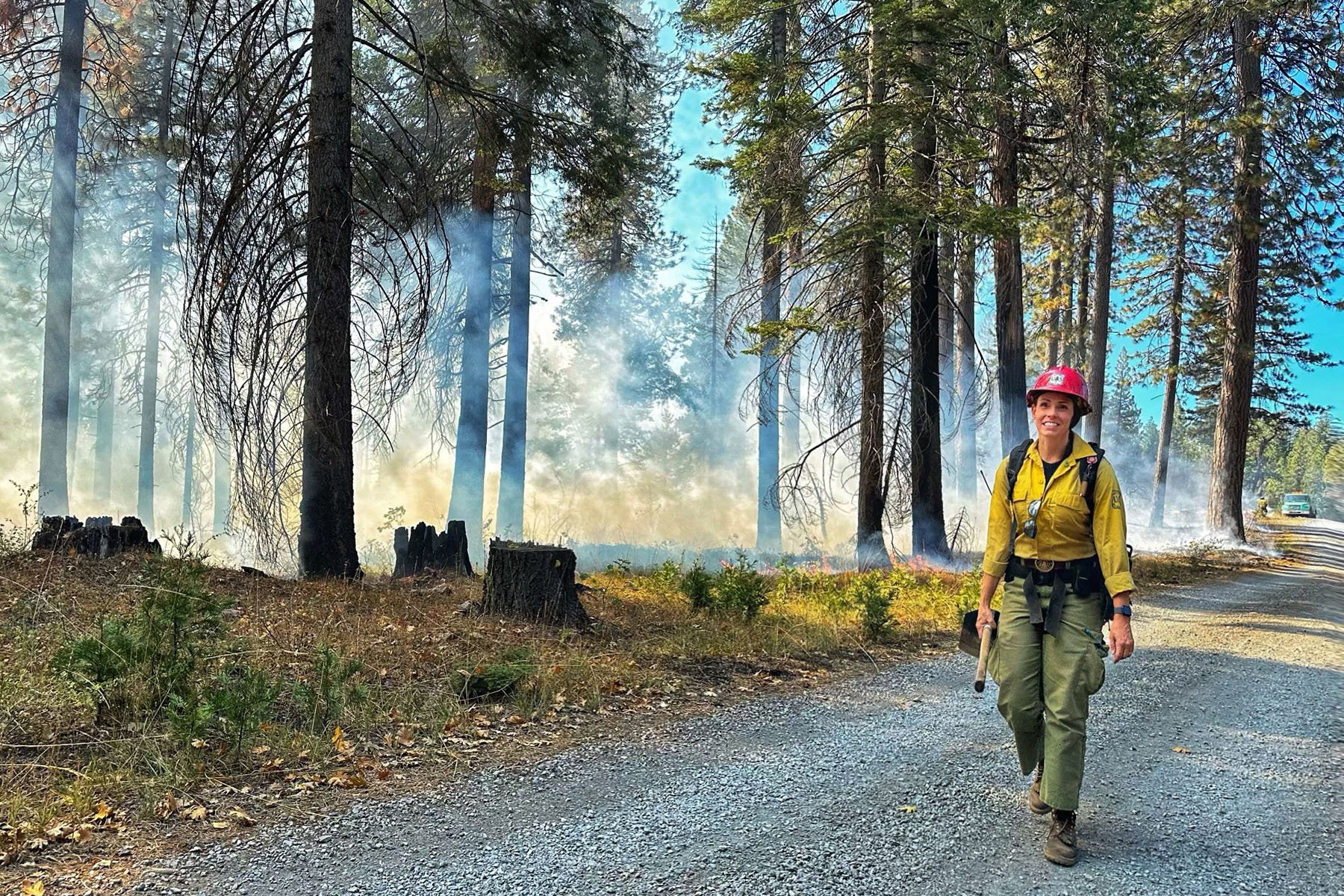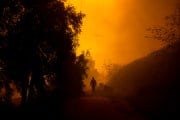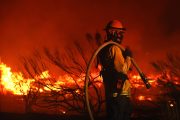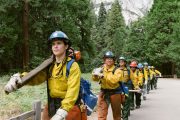It took nearly three years to win presumptive workers’ compensation coverage for breast, cervical, and other cancers that firefighters who work for federal agencies may develop because of hazardous exposures on the job.
Now, just weeks after the Labor Department added coverage for those illnesses, firefighters worry the gains may be in jeopardy after the Trump administration deleted information about the expansion of coverage for cancers that mostly affect women and transgender firefighters from a federal webpage and ducked questions about whether it will uphold the policy change made in the waning days of the Biden administration.
“It’s really important to continue to focus on ensuring that those who devote their lives to protecting the public and communities continue to receive coverage through the special claims unit,” said Pete Dutchick, a federal firefighter and volunteer with the advocacy group Grassroots Wildland Firefighters.
The Labor Department’s special claims unit, established in 2022, processes all federal firefighter claims and provides a streamlined path for those with covered conditions. Wildland firefighters and advocacy groups representing them celebrated that year when federal officials moved to expedite workers’ compensation coverage of cancers tied to their jobs. It was recognition that the dangers of battling wildfires extend long after a blaze is extinguished.
The list of cancers federal officials tagged for streamlined claims processes through the Labor Department’s Office of Workers’ Compensation Programs included esophageal, colorectal, prostate, testicular, kidney, bladder, brain, lung, thyroid, multiple myeloma, non-Hodgkin’s lymphoma, leukemia, mesothelioma, and melanoma.
-
Previous Coverage:
But that initial jubilation soured when it became clear that breast, ovarian, cervical, and uterine cancers were excluded, creating a coverage gap for more than 2,700 people, or about 16% of the more than 17,000 federal wildland firefighters working for the Forest Service and the Interior Department. These are firefighters who are dispatched to federal lands, like in national forests and national parks, and sometimes assist county and state crews, as they did when fires swept into Los Angeles in January.
“At first glance, we were ecstatic,” Dutchick said. “And then we’re like, ‘Well, where are the female cancers?’”
Dutchick, who has an 8-year-old daughter, was upset. “I certainly want her to have equal protections when it comes to health if she chooses to get into a field of public service,” he said.
Then this year, as the Biden administration wound toward a close, federal officials addressed the exclusion, adding the cancers to the list in a last-minute change before Donald Trump took office.
“This policy change acknowledges the unique occupational hazards faced by women firefighters and ensures they receive the care and support they deserve,” Christopher Godfrey, the now-former director of the workers’ compensation office, said in a Jan. 6 statement on the Labor Department’s website.
In a statement to KFF Health News four days later, Godfrey said the policy change resulted in immediate action for firefighters with new claims.
But in the early days of the Trump administration, the January press release announcing the cancer coverage expansion was deleted from the Labor Department website. When asked whether claims were still being processed for the four recently added cancers, a spokesperson for the workers’ compensation office, Frances Alonzo, told KFF Health News, “We do not have any additional updates regarding your inquiry.”
Formalizing the policy change through rulemaking will take months and support from Congress.
-
Read Next:
Kaleena Lynde is among a generation of women firefighters who developed cancer before streamlined coverage for workers’ compensation claims existed. In 2006, Lynde, then 22, was diagnosed with small cell ovarian cancer during her third fire season on the Shasta Lake Hotshots, an elite crew of firefighters in Northern California. Doctors removed a 5.4-pound tumor almost immediately that year. She’s now cancer-free, but only after multiple surgeries, chemotherapy, and an additional cervical cancer diagnosis three years later. Lynde has since gone on to work various jobs for the Forest Service, including 16 years at Eldorado National Forest doing fire investigation, fire prevention, and dispatch center jobs. She now coordinates wildfire apprenticeships for the agency’s Pacific Southwest region.
A friend recently sent her a link to the National Firefighter Registry for Cancer, a database tracking the prevalence of diseases among all firefighters, both structural and wildland. It made Lynde wonder — could her cancers be connected to her work on the fire line?
“I just thought I had bad luck,” Lynde said.
Seeking to fix the omission, more than 15 wildland firefighter advocacy groups, representing Hotshot crews, smokejumpers, and others, signed a September letter to Julie Su, the acting labor secretary at the time. They pointed out that other countries, including Australia, already included presumptive coverage for cervical, ovarian, uterine, and breast cancers.
The Labor Department implemented policy changes that eased the requirements for covering wildland firefighters’ cancer-related workers’ compensation claims in April 2022 through a Federal Employees’ Compensation Act bulletin. The rules were codified in December 2022 when President Joe Biden signed the National Defense Authorization Act.
To qualify, firefighters must have worked for at least five years and be diagnosed within 10 years of their last exposure. Those with unlisted cancers could still file claims through a special unit but wouldn’t receive the same streamlined adjudication for compensation. By September 2024, the workers’ compensation office had received 91 claims for qualifying cancers and heart and lung conditions. Of those, 89 were adjudicated through the special claims process and 84, or 94%, were accepted. Godfrey said that prior to the legislation, only 29% of occupational disease claims for firefighters were accepted.
-
Read Next:
Rachel Granberg, a wildland firefighter in Washington state, said streamlined processing and reimbursements are important. “It really gives people more bandwidth to worry about how they’re going to manage their life after a cancer diagnosis, rather than just fighting for basic health care.”
Too often firefighters end up crowdsourcing for financial support after cancer diagnoses, she said.
George Broyles, retired firefighter and Forest Service researcher, said that health risks are too often seen as part of the job. “Hazard pay is not going to stop cancer,” he said. Broyles wants federal firefighting agencies to be honest about cancer risks when hiring young workers and then educate them on ways to protect themselves.
The recent policy change meant claims for federal wildland firefighters with ovarian, breast, or uterine cancer were immediately directed to the special claims unit and expedited processing.
The Labor Department’s decision to change course and expand presumptive coverage to female reproductive cancers was sudden. In December, the agency released a statement to KFF Health News saying such a change was unwarranted.
Three weeks later — without pointing to any new published research — the agency changed course, citing additional consultation with the National Institute for Occupational Safety and Health and with Steven Moffatt, a doctor who specializes in firefighter illnesses. The agency conducts periodic reviews to consider adding new conditions to its coverage.
The Labor Department’s initial exclusion of female reproductive cancers illuminated the repercussions of research on wildland firefighter health in which women are understudied. One review found that only three out of 20 studies evaluated women firefighters’ cancer risk.
But research has confirmed for years that firefighters are exposed to toxic dangers. A study that followed Florida firefighters for almost 20 years in the 1980s and 1990s found that firefighting increases the overall cancer risk in female firefighters. In 2022, the International Agency for Research on Cancer classified firefighting as a cancer-causing occupation.
Recent research contributed to the agency’s inclusion of female reproductive cancers, Godfrey said. In 2023, a study determined a link between perfluorononanoic acid, a type of PFAS, and uterine cancer. PFAS, which stands for per- and polyfluoroalkyl substances, are a category of chemicals that a recent study found in the protective gear worn by wildland firefighters. Additional research has also linked PFAS exposure to an increase in melanoma. A study published in September identified 12 chemicals that firefighters are exposed to on the job linked to breast cancer.
But now, it’s unclear whether the Trump administration will roll back the new coverage, leaving some federal firefighters unsure whether exposures on the job will leave them scrambling for care.
KFF Health News is a national newsroom that produces in-depth journalism about health issues and is one of the core operating programs at KFF — the independent source for health policy research, polling, and journalism.







